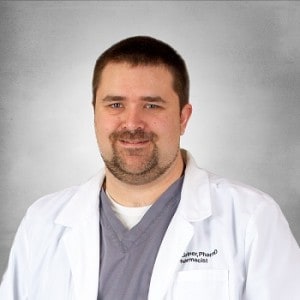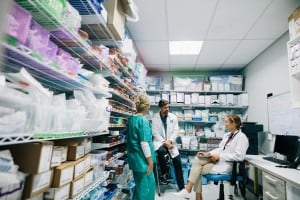As health officials set up a contingency hospital to prepare for a potential surge of COVID-19 patients, Regional One Health’s pharmacy department was called on to help.
Emergency Department Pharmacist Justin Griner led a team that helped recommend which medications the hospital should stock.
It meant starting from scratch to determine therapies and protocols, and they hope to publish what they learned to help medical professionals prepare for future pandemics.
Regional One Health’s mission is to provide lifesaving, compassionate care for patients in times of need. During the COVID-19 pandemic, our pharmacy team is fulfilling that not only inside the hospital’s walls, but in the wider community.
A team led by emergency department pharmacist Justin Griner, PharmD, BCPS is helping set up the local contingency hospital designed for a potential surge.
It means approaching the virus from two different angles.
“The contingency hospital is designed exclusively for patients who are positive for COVID-19 and need to be hospitalized but don’t need to be in an intensive care setting,” Griner said. “They are too sick to be home on their own, but they don’t need the intensive care we have at Regional One Health or other hospitals. The idea is to reserve capacity at the existing hospitals for sicker patients.”
Griner got involved in the project through the Tennessee Pharmacists Association.
Griner got involved in the project through the Tennessee Pharmacists Association. He was tasked with providing support to Denise Pratt, PharmD of First Pharmacy Services, who is overseeing the contingency hospital pharmacy.
“We’re working in a support role to help decide the medications they should stock and help create and edit policies that reflect what they’re trying to do,” he said. “The type of patients they would accept impacts the medications they’ll need. Since these are the lower acuity patients, it’s a smaller range of medications.”

Emergency Department Pharmacist Justin Griner led a team that helped recommend medications for the local contingency hospital. “If it’s needed, it will be able to provide the best possible care,” he said.
Clinical pharmacist David Hill, PharmD, BCPS, BCCCP, said his colleagues didn’t hesitate to put in extra effort. “Everyone went outside their comfort zones and normal scope of practice,” he said. “People are doing things they wouldn’t normally do because more is needed of them – and they want to do it, because they want to help their patients, their team and their community.”
Griner’s team, which includes Hill, David Cunningham, PharmD, BCPS; Paula Hogrefe, PharmD, BCPS; Wes Savage, PharmD, BCCCP; Maegan Rogers, PharmD, BCPS; and pharmacy residents Travis Berkowitz, PharmD and David Ursic, PharmD, started their task by gathering and analyzing the limited information available. Berkowitz, who is from the northeast, lent valuable experience from having worked in what was at the time the nation’s hardest-hit region.
As the virus continued to spread, new and changing data was arriving all the time.
“We try to assimilate that data and get the right therapies in place. It’s fascinating how much data we’ve been able to accumulate in such a short amount of time,” Griner said. “To have so many researchers focused on one disease is unprecedented, and by connecting experts around the world, an amazing amount of information has come together quickly.”
Griner said his pharmacy colleagues, as well as Regional One Health doctors and nurses, are an invaluable resource. Together, their collective experience and knowledge have allowed them to recommend pharmaceutical therapies for a type of patient they’ve never treated before.
“We’re still learning what works and what doesn’t,” he said. “Our job is to parse through the literature and data to determine the best therapy in any situation, not just COVID-19. That’s what we do as clinical pharmacists, so we’re uniquely positioned to be a source of information.”
While the contingency hospital has not had to be activated, Griner is confident it is ready if needed. “Of course, we’re hoping we never have to open it – the goal is to keep COVID-19 under control so regular hospital capacity is not exceeded. But if it is needed, it will be able to provide the best possible care.”
Working on the community-wide effort is just one way the pharmacy team is staying connected with the larger fight against coronavirus.

Pharmacists relied on emerging data and their experience and expertise to determine which medications the hospital would need to treat patients.
“We have some amazing pharmacists who are wholeheartedly ingrained within local, regional, national and international efforts,” Hill said. “Our team has assisted in creating local and national protocols and contingency plans as we stay prepared for cycling shortages, and we’re facilitating national and international discussion between providers, which has been a critical component of expedited delivery of real-world experiences.”
Griner and Drew Armstrong, PharmD, BCACP, AAHIVP, are contributing to state legislation to increase the legal scope of pharmacy practice. Griner also moderates social media platforms for medical professionals, a role he uses to debunk misinformation and to give pharmacists and other health care professionals facts they can use to improve patient care and safety.
“Social media enables us to connect, but there are negatives,” he said. “I’ve made it my mission to only share the best information available and to counteract some of the misinformation that’s floating around. It’s a constantly moving target, but I try to provide a trustworthy resource.”
Ultimately, he’d like to work with his colleagues to publish what they’ve learned, all in the name of continuing to help the medical community better serve patients.
“We had to start from scratch because there wasn’t a playbook in place; there were no protocols in place,” he said. “Down the road, we want to publish or at least disseminate our experience with the field hospital. If we can share what we learned with others, they’ll be that much further along. Even if it isn’t COVID-19, having this information would be a starting point.”

